The Intel Haswell-E CPU Review: Core i7-5960X, i7-5930K and i7-5820K Tested
by Ian Cutress on August 29, 2014 12:00 PM ESTGaming Benchmarks
One of the important things to test in our gaming benchmarks this time around is the effect of the Core i7-5820K having 28 PCIe 3.0 lanes rather than the normal 40. This means that the CPU is limited to x16/x8 operation in SLI, rather than x16/x16.
F1 2013
First up is F1 2013 by Codemasters. I am a big Formula 1 fan in my spare time, and nothing makes me happier than carving up the field in a Caterham, waving to the Red Bulls as I drive by (because I play on easy and take shortcuts). F1 2013 uses the EGO Engine, and like other Codemasters games ends up being very playable on old hardware quite easily. In order to beef up the benchmark a bit, we devised the following scenario for the benchmark mode: one lap of Spa-Francorchamps in the heavy wet, the benchmark follows Jenson Button in the McLaren who starts on the grid in 22nd place, with the field made up of 11 Williams cars, 5 Marussia and 5 Caterham in that order. This puts emphasis on the CPU to handle the AI in the wet, and allows for a good amount of overtaking during the automated benchmark. We test at 1920x1080 on Ultra graphical settings.
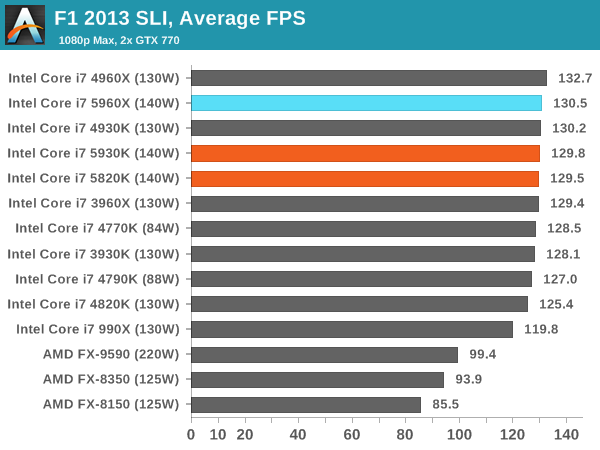
Nothing here really shows any advantage of Haswell-E over Ivy Bridge-E, although the 10% gaps to the 990X for minimum frame rates offer some perspective.
Bioshock Infinite
Bioshock Infinite was Zero Punctuation’s Game of the Year for 2013, uses the Unreal Engine 3, and is designed to scale with both cores and graphical prowess. We test the benchmark using the Adrenaline benchmark tool and the Xtreme (1920x1080, Maximum) performance setting, noting down the average frame rates and the minimum frame rates.
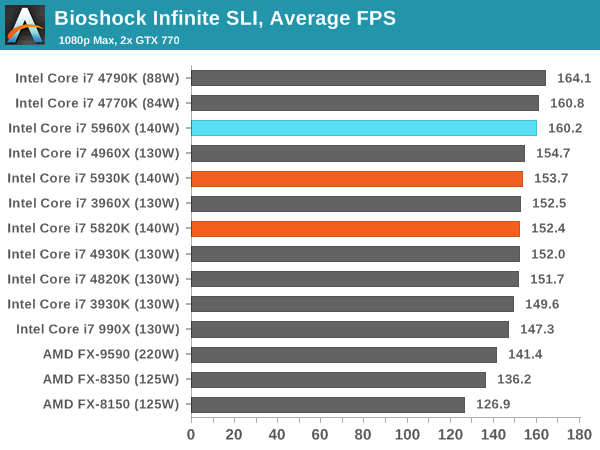
Bioshock Infinite likes a mixture of cores and frequency, especially when it comes to SLI.
Tomb Raider
The next benchmark in our test is Tomb Raider. Tomb Raider is an AMD optimized game, lauded for its use of TressFX creating dynamic hair to increase the immersion in game. Tomb Raider uses a modified version of the Crystal Engine, and enjoys raw horsepower. We test the benchmark using the Adrenaline benchmark tool and the Xtreme (1920x1080, Maximum) performance setting, noting down the average frame rates and the minimum frame rates.
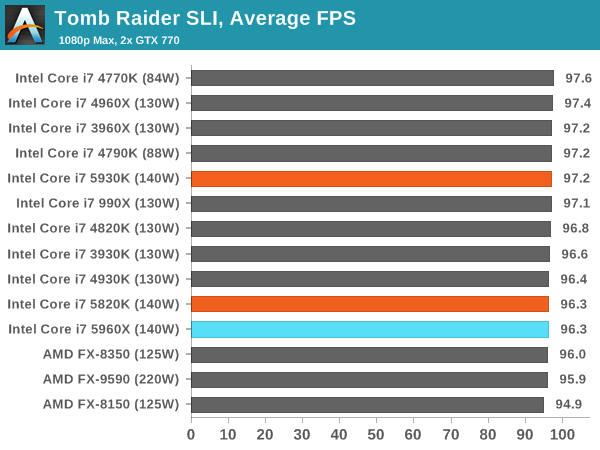
Tomb Raider is blissfully CPU agnostic it would seem.
Sleeping Dogs
Sleeping Dogs is a benchmarking wet dream – a highly complex benchmark that can bring the toughest setup and high resolutions down into single figures. Having an extreme SSAO setting can do that, but at the right settings Sleeping Dogs is highly playable and enjoyable. We run the basic benchmark program laid out in the Adrenaline benchmark tool, and the Xtreme (1920x1080, Maximum) performance setting, noting down the average frame rates and the minimum frame rates.
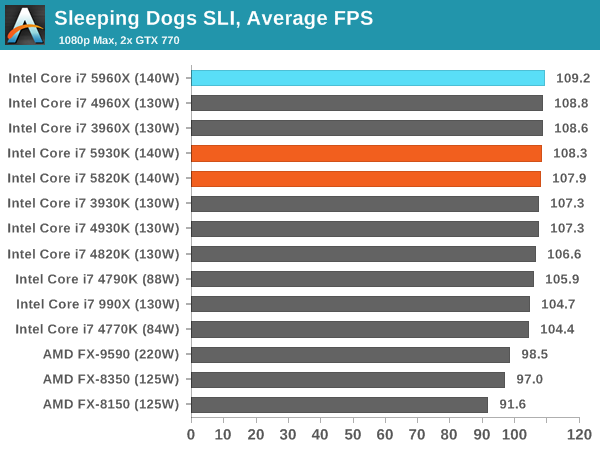
The biggest graph of CPU performance change is the minimum frame rate while in SLI - the 5960X reaches 67.4 FPS minimum, with only the xx60X CPUs of each generation moving above 60 FPS. That being said, all the Intel CPUs in our test are above 55 FPS, though it would seem that the 60X processors have some more room.
Battlefield 4
The EA/DICE series that has taken countless hours of my life away is back for another iteration, using the Frostbite 3 engine. AMD is also piling its resources into BF4 with the new Mantle API for developers, designed to cut the time required for the CPU to dispatch commands to the graphical sub-system. For our test we use the in-game benchmarking tools and record the frame time for the first ~70 seconds of the Tashgar single player mission, which is an on-rails generation of and rendering of objects and textures. We test at 1920x1080 at Ultra settings.
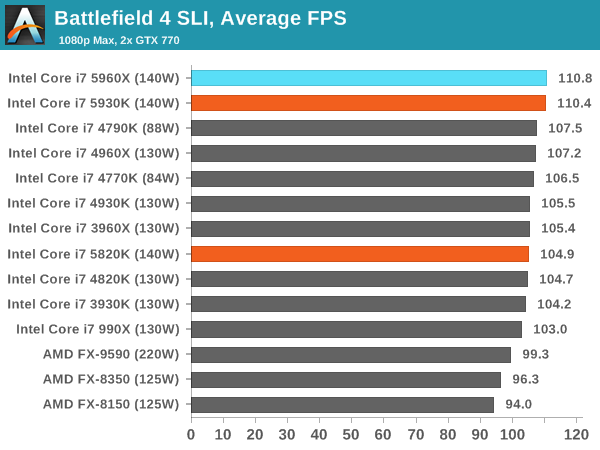
Battlefield 4 is the only benchmark where we see the 5820K with its 28 PCIe lanes down by any reasonable margin against the other two 5xxx processors, and even then this is around 5% when in SLI. Not many users will notice the difference between 105 FPS and 110 FPS, and minimum frame rates are still 75 FPS+ on all Intel processors.















203 Comments
View All Comments
Ian Cutress - Monday, September 1, 2014 - link
When I tested the 5930K/5820K, the motherboard BIOSes were still very early alpha builds and did not allow overclocking. If I can get these CPUs in again to test (they had to be sent back), I will do some overclocking results for sure.jwcalla - Friday, August 29, 2014 - link
Might as well wait for them to fix TSX at this point.iwod - Friday, August 29, 2014 - link
How likely will this be in Mac Pro?DigitalFreak - Friday, August 29, 2014 - link
Doubtful. Apple is using Xeons in the Mac Pro.hansmuff - Friday, August 29, 2014 - link
I'll be waiting for two more generations. Maybe something worthwhile comes along to replace my 2600k at 4.4GHz. I'm glad the review shows so clearly where this new chip excels and who should save their money.Yuriman - Friday, August 29, 2014 - link
Typo:"Modules should be available from DDR3-2133 to DDR3-3200 at launch, with the higher end of the spectrum being announced by both G.Skill and Corsair. See our DDR4 article later this week for more extensive testing."
TelstarTOS - Friday, August 29, 2014 - link
Good article but the overclocking comparisons are a bit limited, i.e. 5930K and 5920K overclocking tables are not provided, nor a comparison with older SB/IB cpu @around 4,5ghz which most people still have and are deciding whether to upgrade to a X99 or a Z97 platform.A more accurate RAM performance comparison is also missing.
Ian Cutress - Monday, September 1, 2014 - link
At the time I had the 5930K/5820K, I was not in a position to be able to overclock due to early alpha firmware. Due to our newer benchmarking suite, I still need to go back to the early Sandy (non-E) CPUs to retest. Anything you see in Bench with the power listed has been retested at least in part this year, depending on my scheduling. Unfortunately I don't have the space to have this as an ongoing project, it occurs in time with reviews.name99 - Friday, August 29, 2014 - link
"For the six core models, the i7-5930K and the i7-5820K, one pair of cores is disabled; the pair which is disabled is not always constant, but will always be a left-to-right pair from the four rows as shown in the image. Unlike the Xeon range where sometimes the additional cache from disabled cores is still available, the L3 cache for these two cores will be disabled also."Are you sure that these various statements are correct? I'm not doubting you, but I would point out that at Hot Chips 2014 discussing the Xeon IVB server, Intel stated that they'd designed the floorplan to be "choppable".
They gave a diagram that showed a base of fifteen (3x5) CPUs+L3 slices, which chop lines to take off a th3 right-hand 5 CPUs, then to take off one or two of the horizontal pairs (taking the 10 CPus down to 8 and then 6).
Point is:
- the impression they gave is that these reduced CPU counts are not (at least not PRIMARILY) from full dies with disabled (or nonfunctional) cores --- they are manufactured to have smaller area with fewer cores.
- which suggests that versions with fewer cores but larger cache are some sort of anomaly (because the chop cuts out L3 slices along with cores). Perhaps THOSE are the chips that really did have one or two non-functional cores but with still functional L3 slices?
Ian Cutress - Monday, September 1, 2014 - link
As far as we know, the floorplan for the die for i7 is an 8-core, with the 6-core models being disabled versions rather than wholly new dies.With the Ivy-E Xeons, there are a number of CPUs that have high L3 per core numbers due to the way the cores are disabled - Intel usually sticks to 3 floor plans or so depending on how their product line is stacked up. This may change with Haswell-E, though the Xeons have not been officially released yet. The Ivy-E floorplans can be found here, where I did a breakdown of L3/core:
http://www.anandtech.com/show/7852/intel-xeon-e526...